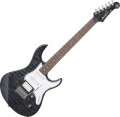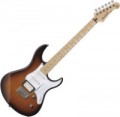Pickup switch
A type of pickup switch used on an electric guitar.
This switch is responsible for turning individual pickups on and off, and can also control coil cutoff (see above). Accordingly, the manufacturer chooses its type primarily depending on the number of pickups (see "Pickup Diagram"). So, 3-position switches are typical mainly for models with two pickups — they usually allow you to turn on each of them separately or use both at once. The 5-position controls are common on 3-pickup models with stratocaster or superstrat bodies (see “Shape (Appearance)”). Note that the specific combinations of pickups available in such instruments may be different, this point will not hurt to clarify separately. The most advanced option — a 6-position switch — is extremely rare, mainly in expensive custom class instruments.
A separate type of switch is the balance control, used mainly in bass guitars (see "Type"). They are not responsible for turning off individual pickups (there are usually two of them), but for changing their volume relative to each other. Roughly speaking, these are two volume controls for separate pickups, combined in one knob (of course, there are also two pickups in such instruments). In fact, the balance control in this case also provides a smooth change in timbre: the pickup near the bridge picks up high frequencies better, the pickup near the fretboard picks up lower frequencies, respectively, and the colour of the sound changes depending on which of t...hem sounds louder.
Body top
The material from which the soundboard cover is made is an additional overlay on the upper soundboard, which primarily plays a decorative role and gives the instrument a pleasant appearance. Do not confuse such a cover with a protective overlay (see above about it). And in semi-acoustic instruments with a hollow body (see "Type"), this paragraph may indicate the material of the upper soundboard, and a separate cover as such may be absent.
In general, the value of this parameter is similar to the material of the body (see above) — adjusted for the fact that the deck cover also directly determines the appearance of the electric guitar, and in semi-acoustic models it affects the sound more than the rest of the body. However, the main criterion for choosing this parameter may well be the aesthetic preferences of the musician.
Neck profile
Profile of a fretboard mounted on an electric guitar.
The profile of the neck is called its shape in section, more precisely, the shape of the back of the neck. This parameter practically does not affect the sound of the guitar, but it directly affects the convenience of playing. Ideally, the neck should “fill” the hand, but not be too large — otherwise it will not be possible to clasp it to the right extent.
Profiles are denoted by the letters C, D, V and U — depending on which letter the neck resembles in the section. Profile D is the flattest, C is slightly more convex, with almost uniform curvature along the entire length, U is more voluminous, with a wider profile in the area of the lining, and the V profile in its classic form has the form of an angle with a rounded top. There are also modifications of these options — for example, "thin", which provides for a reduced profile thickness, or "modern", with slightly improved (theoretically) ergonomics.
The most popular profile types are
C,
U and their "modern" (modern) modifications. The C profile is almost semi-circular, the U profile is more voluminous, at the fingerboard its edges are almost parallel and only closer to the back of the neck are sharply rounded. The terms
modern C and
modern U refer to various improved versions of these profiles, their f
...orm may be different.
In fact, the choice of neck profile depends solely on the guitarist's personal preferences, the characteristics of his hands and his preferred playing technique. Thus, there is no "perfect" profile shape — in each case, the optimal choice will be different. The perfect option is to try several types of profile "live", decide which one will be more convenient, and choose an instrument with a neck of the same or similar profile shape.Fretboard radius
The radius of curvature of a fretboard mounted on the fretboard of an electric guitar.
The fingerboard is located directly under the strings, it is to it that the musician presses the strings when playing. If you look at the neck in cross section, its upper part with the overlay will have the shape of an arc; the radius of this arc is implied in this case. The smaller the radius, the more convex this arc will be, and vice versa, a large radius will correspond to an almost flat surface.
In general, it is believed that a smaller fingerboard radius is better for playing chords, and a more even, flat surface makes it easier to play technical passages with an abundance of special techniques such as bands. The average and, one might say, classic diameter value is 12", this is the most popular option among modern electric guitars. The smallest figure is just over 7", it is found in some guitars with Stratocaster bodies (both original Fender instruments and copies ). And the most flat pads have a diameter of 20" or more.
Note that there are often instruments with a variable fretboard radius — smaller at the headstock (where chords are played more often) and larger near the body (where solos are played by notes). In such cases, the radius at the nut is indicated.

